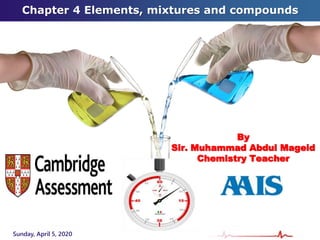
4 1 revisiting the particle model - aais
- 1. Chapter 4 Elements, mixtures and compounds Sunday, April 5, 2020 By Sir. Muhammad Abdul Mageid Chemistry Teacher
- 2. Contents 4.3 Diffusion 4.1 Revisiting the particle model 4.4 Atoms, molecules and elements 4.2 Gas Pressure 4.7 Elements and compounds 4.5 Chemical symbols and formulae 4.8 Forming compounds from elements 4.6 introducing the periodic table 4.9 Investigating elements ,mixtures and compounds Sunday, April 5, 2020 Sir. Muhammad Abdul Mageid
- 3. Sunday, April 5, 2020 Chapter Student Book topic Framework point Chemistry: Chapter 4: Elements, Mixtures and Compounds 4.1 Revisiting the particle model Show how the particle theory of matter can be used to explain the properties of solids, liquids and gases, including changes of state 4.1 Revisiting the particle model Sir. Muhammad Abdul Mageid
- 4. 4.1 Revisiting the particle model Sunday, April 5, 2020 Everything is Made of Particles Made of particles Rock, air, and water look very different. But they have one big thing in common: they are all made of very tiny pieces, far too small to see. Particles on the move In rock and other solids, the particles are not free to move around. But in liquids and gases, they move freely. As they move they collide with each other, and bounce off in all directions. So the path of one particle, in a liquid or gas, could look like the opposite figure: Sir. Muhammad Abdul Mageid
- 5. Sunday, April 5, 2020 4.1 Revisiting the particle model States of matter : Solids, Liquids, and Gases What’s the difference? It is easy to tell the difference between a solid, a liquid and a gas: Sir. Muhammad Abdul Mageid
- 6. Sunday, April 5, 2020Sunday, April 5, 2020 4.1 Revisiting the particle model A solid has a fixed shape and a fixed volume. Can not flow. Can not be compressed Particles are lined up next to each other They are fixed in position but do vibrate A liquid has no fixed shape and a fixed volume. Can flow. Very difficult to compress Particles are still very close but can slip and slide over each other A gas has no fixed shape and spreads out to fill its container Can flow. Easily compressed Particles move rapidly around at random and there is lots of space within the gas Sir. Muhammad Abdul Mageid
- 7. Sunday, April 5, 2020Sunday, April 5, 2020 4.1 Revisiting the particle model The Particles in Solids, Liquids, and Gases State How the particles are arranged Particles Diagram Solids The particles in a solid are arranged in a fixed pattern or lattice. Strong forces hold them together. So they cannot leave their positions. The only movements they make are tiny vibrations to and fro. Liquids The particles in a liquid can move about and slide past each other. They are still close together, but not in a lattice. The forces that hold them together are weaker than in a solid. Gases The particles in a gas are far apart, and they move about very quickly. There are almost no forces holding them together. They collide with each other and bounce off in all directions. Sunday, April 5, 2020 Sir. Muhammad Abdul Mageid
- 8. Sunday, April 5, 2020Sunday, April 5, 2020 4.1 Revisiting the particle model Sir. Muhammad Abdul Mageid
- 9. Sunday, April 5, 2020 4.1 Revisiting the particle model Change Definition Type of process Melting The change of matter from solid state to liquid state by heating [absorbing energy] Endothermic process Boiling/ Evaporation The change of matter from liquid state to gaseous state by heating [absorbing energy] Endothermic process Condensation The change of matter from gaseous state to liquid state by cooling [releasing energy] Exothermic process Freezing / Solidifying The change of matter from liquid state to solid state by cooling [releasing energy] Exothermic process Sir. Muhammad Abdul Mageid
- 10. Sunday, April 5, 2020 4.1 Revisiting the particle model Explanation of Changing state[ Using the particle theory] Boiling When a liquid is heated, its particles get more energy and move faster. They bump into each other more often, and bounce further apart. This makes the liquid expand. At the boiling point, the particles get enough energy to overcome the forces between them. They break away to form a gas: Evaporation Some particles in a liquid have more energy than others. Even well below the boiling point, some have enough energy to escape and form a gas. This is called evaporation. It is why puddles of rain dry up in the sun. Heat Energy Heat Energy at melting point Sir. Muhammad Abdul Mageid
- 11. Sunday, April 5, 2020 4.1 Summary Quistions 1. Using the idea of particles, explain why: a- liquids flow but solids do not flow b- solids have a fixed shape but liquids and gases take up the shape of their containers 2. Define the following words: a- boiling b- melting c- condensing d- freezing 3. Using the particle theory , explain what happens when: a- we heat a solid until it melts b- we heat a liquid until it boils Sir. Muhammad Abdul Mageid
- 12. Sunday, April 5, 2020 4.1 Past Papers Questions The following diagram shows the three states of matter and how they can be interchanged i- Name the changes A , B , C and D ii- Which of the changes A , B , C or D will involve: 1) an input of heat energy ? 2) an output of heat energy ? Sir. Muhammad Abdul Mageid
